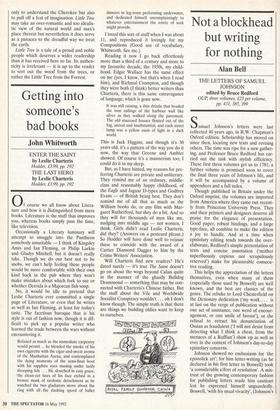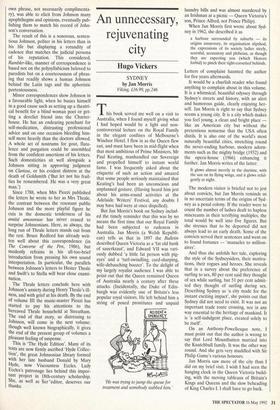Not a blockhead but writing for nothing
Alan Bell
THE LETTERS OF SAMUEL JOHNSON edited by Bruce Redford OUP, three volumes, £25 per volume, pp. 431, 385, 399 Samuel Johnson's letters were last collected 40 years ago, in R.W. Chapman's Oxford edition. Scholarship has moved on since then, locating new texts and revising others. The time was ripe for a new gather- ing, and Professor Bruce Redford has car- ried out the task with stylish efficiency. These first three volumes get us to 1781; a further volume is promised soon to cover the final three years of Johnson's life, and it will be accompanied by a yolume of appendices and a full index.
Though published in Britain under the Oxford imprint, the volumes are imported from America where they came out recent- ly from Princeton University Press. They and their printers and designers deserve all praise for the elegance of presentation. Good paper, robust bindings, and a large type-face, all combine to make the edition a joy to handle. And at a time when epistolary editing tends towards the over- elaborate, Redford's simple presentation of texts and concise annotation ('neither superfluously copious nor scrupulously reserved') make for pleasurable consecu- tive reading.
This helps the appreciation of the letters themselves, even when many of them (especially those used by Boswell) are well known, and the best are classics of the genre. The rebuke to Lord Chesterfield on the Dictionary dedication ('my work . . . is at last on the verge of publication without one act of assistance, one word of encour- agement, or one smile of favour'), or the refusal to retract his denunciation of Ossian as fraudulent CI will not desist from detecting what I think a cheat, from the menaces of a Ruffian') show up as well as ever in the context of Johnson's day-to-day epistolary concerns.
Johnson showed no enthusiasm for 'the epistolick art'; for him letter-writing (as he declared in his first letter to Boswell) took 'a considerable effort of resolution'. A mis- trust of the growing contemporary fashion for publishing letters made him cautious lest he expressed himself unguardedly. Boswell, 'with his usual vivacity', (Johnson's own phrase, not necessarily complimenta- ry), was able to elicit from Johnson many apophthegms and opinions, eventually pub- lishing them to match his record of John- son's conversation.
The result of this is a sonorous, senten- tious Johnson, politer in his letters than in his life but displaying a rotundity of cadence that matches the judicial persona of his reputation. This considered, Rambler-like, manner of correspondence is based not on the polysyllabicism beloved to parodists but on a courteousness of phras- ing that readily shows a human Johnson behind the Latin tags and the aphoristic portentousness.
Minor correspondences show Johnson in a favourable light, when he busies himself in a good cause such as setting up a theatri- cal benefit for a blind woman poet or get- ting a derelict friend into the Charter- house. He has an endearing penchant for self-medication, distrusting professional advice and on one occasion bleeding him- self more heavily than the doctors allowed. A whole set of nostrums for gout, flatu- lence and purgation could be assembled from the confident assertions of his letters. Such domesticities sit well alongside a Johnson sitting in approving judgment on Clarissa, or his evident distress at the death of Goldsmith (Tut let not his frail- ties be remembered. He was a very great man.)
Since 1788, when Mrs Piozzi published the letters he wrote to her as Mrs Thrale, the contrast between the resonant public Johnson and the more playful figure he cuts in the domestic tenderness of his amitie amoureuse has never ceased to surprise Johnsonians. Here, as always, the long run of Thrale letters stands out from the rest. Bruce Redford has already writ- ten well about this correspondence (in The Converse of the Pen, 1986), but modestly refrains in his all-too-brief introduction from pressing his own sound interpretation. In particular, the parallels between Johnson's letters to Hester Thrale and Swift's to Stella will bear close exami- nation.
The Thrale letters conclude here with Johnson's anxiety during Henry Thrale's ill- ness, and with grief at his death. By the end of volume III the music-master Piozzi has started to pay his attentions to the bereaved Thrale household at Streatham.
The end of that story, so distressing to Johnson, will come in the next volume: though well known biographically, it gives the end of the present group of volumes a pleasant feeling of suspense. This is 'The Hyde Edition'. Many of its texts are now firmly ascribed 'Hyde Collec- tion', the great Johnsonian library formed with her late husband Donald by Mary Hyde, now Viscountess Eccles. Lady Eccles's patronage lies behind this impor- tant project in 18th-century scholarship. She, as well as tier 'editor, deserves our thanks.



















































 Previous page
Previous page